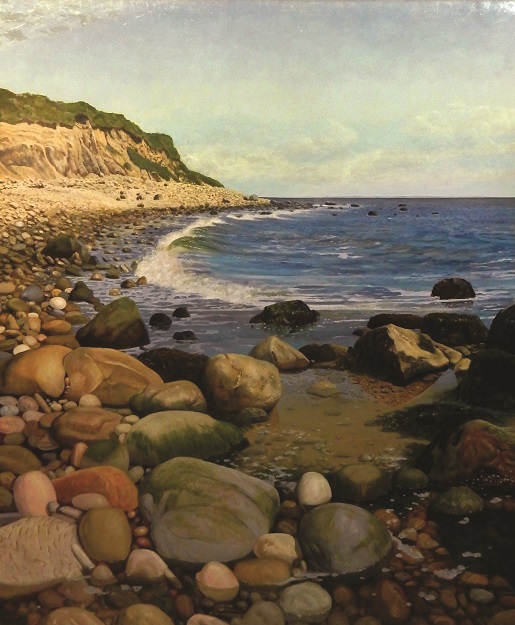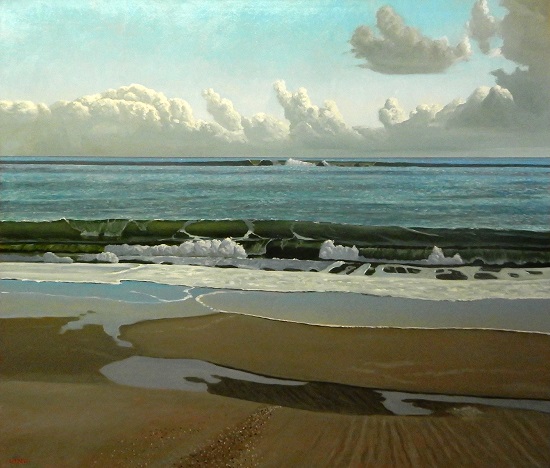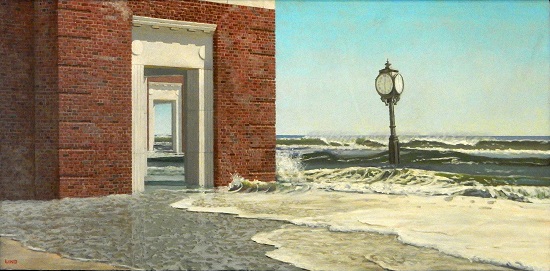In keeping with the season’s breach of the indoor/outdoor threshold, the Kingsborough Art Museum (KAM) situated on the eastern tip of Coney Island and encircled by Sheepshead Bay, is presenting an exhibition of 23 canvases reflecting painter Frank Lind’s fascination with Long Island’s shoreline. On view through May 15, 2019, Lind is the former chairperson of Fine Arts at Pratt Institute, former Dean of Pratt’s School of Art and Design, and a devotee of the ocean’s edge; his painting examines a familiar subject from a uniquely multifarious perspective.
The exhibition is a merging of a day at the shore and a gallery visit—requiring a 90-minute subway-to-bus trek from Union Square—but the trip is clearly worth the effort. And as many art lovers already know, such excursions represent a new norm. Art fair bazaars and overhyped gallery shows that substitute profusion for inclusiveness proffer an increasingly limited view of what’s happening. To find serious painting one must be willing to embrace the diaspora and the day trips the diaspora demands.
.

"Discobolus" by Frank Lind, 1997. Oil on canvas, 80 x 60 inches. Courtesy of the artist.
.
Though unfortunate in some ways, art’s geographical expansion benefits college venues like KAM, a formidable institution built on a half-century of history as the art gallery at CUNY’s Kingsborough Community College in Brooklyn. Like its many regional cohorts, KAM is well-established, generously appointed, academically managed, and situated among a population of students and faculty whose interest in art is distinctively noncommercial. Such venues are perfectly positioned to mount ambitious exhibitions of under-represented artists.
Titled “Time and Tide,” the title of one of the works on view and a nod to a phrase of unknown origin that speaks to the temporal and physical scale of Frank Lind’s project, the siting for this particular exhibition is particularly apt, just steps from the water’s edge. For what sets Lind’s landscapes apart from other representational painters is his need to merge the emotional promise of ephemeral light effects with a specificity of physical information that goes beyond the choice of motif or the careful noting of particulars. In acceding to a broad and personal sense of wonder that is both aesthetic and scientific, Lind proves able to create a painterly accord between our fascination with the sea, our environmental apprehensions and our appetite for visual order.
.

"Littoral" by Frank Lind, 2017. Oil on canvas, 84 x 72 inches. Courtesy of the artist.
.
Employing both plein-air and lens-based methods in his extensive prep work, including an intriguing use of stereoscopic photography, Lind’s canvases remain fundamentally native and instinctual. Employing a mitigated hard-edge and an intensely chromatic palette, these sturdy compositions somehow understate their assembled history. Larus, a typical Lind composite of several studies incorporating images of sea birds near and far that are not only rendered with accurate features but are situated in the artist’s fabricated space by reliable cartesian rubrics. And yet the painting reads as experienced in the moment, with a convincing sense of unstressed observation. There is no overt sign of the complex artifice behind it.
.

"Larus" by Frank Lind, 2012. Oil on canvas, 84 x 72 inches. Courtesy of the artist.
.
Knowledge of the artist’s methodology—unavailable to the viewer without a wall text or catalog, both of which are available at the exhibition—brings to mind the hidden foundation underlying the work of Thomas Eakins, whose utilization of systems never interfered with a viewer’s pictorial experience. As in paintings by Eakins, Lind’s arrangements look intuitively achieved. Lind’s color, though, is wider in spectrum and distributed with nuance and variation when compared with the often fussy, localized palette and nostalgic tenebrism of Eakins.
Fortified with substantial knowledge of a beach’s environmental structure while alert to pictorial potential, Lind’s choice of motif is indicative of his dual art/science sensibility. Oyster Pond, a 10- by 5-foot canvas, spreads from a perpendicular view of a dune separating the sea on the left from a lake of trapped seawater on the right. The comparison of the agitated surf on one side of the dune with the reflective quietude of the pond on the right become the painting’s subject, emphasized by a split two-panel format, achieved by matching the aspect ratio in both the smaller and larger sections. Coordinating all this is itself impressive.
.

"Oyster Pond" by Frank Lind, 2019. Oil on canvas
diptych, 60 x 122 inches. Photo: Peter Malone.
.
The chromatic intensity of Tilden Beach demonstrates Lind’s facility for rendering light. With a bank of cumulus clouds hugging the horizon, the cobalt sea outlined by receding breakers, and the unusual choice of a late afternoon raking light, Lind renders a view of the ocean, the soaked sand and momentary tidal ponds that almost miraculously manages to avoid referencing any single painter among the legions who have addressed similar views.
.

"Tilden Beach" by Frank Lind, 2010. Oil on canvas, 60 x 72 inches. Courtesy of the artist.
.
The 4-foot canvas Time and Tide demonstrates Lind’s focus on recent environmental events, while holding to the same consistency of composition, light and pictorial structure. Supplementing this already complex orchestration, Lind unifies the narrative by employing symbolism. A limestone neo-classical brick-framed doorway, echoed in the open-air space seen within, stands solidly against the sea lapping at its foundation. In contrast, an ornate boardwalk clock inundated with floodwaters lists inland, unable to resist a storm surge indicated by mists of seawater windswept off the ridge of incoming waves. And all this under a pristine, cloudless afternoon sky—Edward Hopper’s innate sense of drama, seen and raised.
.

"Time and Tide" by Frank Lind, 2011. Oil on canvas, 23 x 48 inches. Courtesy of the artist.
.
With 20 more paintings on view—each sharing in the same consolidation of intuitive painting and scientific field work pertaining to this magical zone of the natural environment—a short review can provide only a sampling of what can be absorbed in Frank Lind’s and KAM’s version of an afternoon by the sea.
_______________________
BASIC FACTS: “Frank Lind: Time and Tide” is on view April 17 to May 15, 2019 at the Kingsborough Art Museum, CUNY Kingsborough Community College, Arts & Sciences Building, 2001 Oriental Boulevard, Brooklyn, NY 11235. www.kccgallery.org.
_______________________
Copyright 2019 Hamptons Art Hub LLC. All rights reserved.
